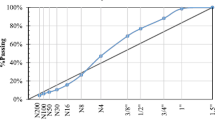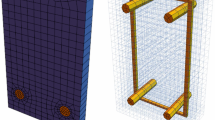Abstract
This paper presents a quasi-static multiscale computational model with its verification and rational applications to mechanical behavior predictions of asphaltic roadways that are subject to viscoelastic deformation and fracture damage. The multiscale model is based on continuum thermo-mechanics and is implemented using a finite element formulation. Two length scales (global and local) are two-way coupled in the model framework by linking a homogenized global scale to a heterogeneous local scale representative volume element. With the unique multiscaling and the use of the finite element technique, it is possible to take into account the effect of material heterogeneity, viscoelasticity, and anisotropic damage accumulation in the small scale on the overall performance of larger scale structures. Along with the theoretical model formulation, two example problems are shown: one to verify the model and its computational benefits through comparisons with analytical solutions and single-scale simulation results, and the other to demonstrate the applicability of the approach to model general roadway structures where material viscoelasticity and cohesive zone fracture are involved.
Similar content being viewed by others
References
Masad E, Niranjanan S, Bahia H, Kose S (2001) Modeling and experimental measurements of localized strain distribution in asphalt mixes. J Transp Eng 127(6): 477–485
Papagiannakis AT, Abbas A, Masad E (2002) Micromechanical analysis of viscoelastic properties of asphalt concretes. Transp Res Rec 1789: 113–120
Guddati MN, Feng Z, Kim YR (2002) Towards a micromechanics-based procedure to characterize fatigue performance of asphalt concrete. Transp Res Rec 1789: 121–128
Sadd MH, Dai Q, Parameswaran V, Shukla A (2003) Simulation of asphalt materials using a finite element micromechanical model with damage mechanics. Transp Res Rec 1832: 86–95
Soares BJ, Freitas F, Allen DH (2003) Crack modeling of asphaltic mixtures considering heterogeneity of the material. Transp Res Rec 1832: 113–120
Dai Q, Sadd MH, Parameswaran V, Shukla A (2005) Prediction of damage behaviors in asphalt materials using a micromechanical finite-element model and image analysis. J Eng Mech 131(7): 668–677
Buttlar W, You Z (2001) Discrete element modeling of asphalt concrete: microfabric approach. Transp Res Rec 1757: 111–118
Kim H, Buttler WG (2005) Micromechanical fracture modeling of hot-mix asphalt concrete based on a disk-shaped compact tension test. Electron J Assoc Asph Paving Technol 74E:209–223
Abbas A, Masad E, Papagiannakis T, Shenoy A (2005) Modeling of asphalt mastic stiffness using discrete elements and micromechanics analysis. Int J Pavement Eng 6(2): 137–146
Fish J, Wagiman A (1993) Multiscale finite element method for a locally non-periodic heterogeneous medium. Comput Mech 12: 164–180
Fish J, Belsky V (1995) Multigrid method for periodic heterogeneous media, part II: multiscale modeling and quality control in multidimensional cases. Comput Methods Appl Mech Eng 126: 17–38
Oden JT, Zohdi TI (1997) Analysis and adaptive modeling of highly heterogeneous elastic structures. Comput Methods Appl Mech Eng 172: 3–25
Feyel F (1999) Multiscale FE2 elastoviscoplastic analysis of composite structures. Comput Mater Sci 16: 344–354
Lee K, Moorthy S, Ghosh S (1999) Multiple scale computational model for damage in composite materials. Comput Methods Appl Mech Eng 172: 175–201
Oden JT, Vemaganti K, Moes N (1999) Hierarchical modeling of heterogeneous solids. Comput Methods Appl Mech Eng 148: 367–391
Feyel F, Chaboche JL (2000) FE2 multiscale approach for modeling the elastoviscoplastic behavior of long fibre SiC/Ti composite materials. Comput Methods Appl Mech Eng 183: 309–330
Fish J, Shek K (2000) Multiscale analysis of composite materials and structures. Compos Sci Technol 60: 2547–2556
Ghosh S, Lee K, Raghavan P (2001) A multi-level computational model for multiscale damage analysis in composite and porous materials. Int J Solids Struct 38: 2335–2385
Raghavan P, Moorthy S, Ghosh S, Pagano NJ (2001) Revisiting the composite laminate problem with an adaptive multi-level computational model. Compos Sci Technol 61: 1017–1040
Haj-Ali RM, Muliana AH (2004) A multi-scale constitutive formulation for the nonlinear viscoelastic analysis of laminated composite materials and structures. Int J Solids Struct 41: 3461–3490
Dugdale DS (1960) Yielding of steel sheets containing slits. J Mech Phys Solids 8: 100–104
Barenblatt GI (1962) The mathematical theory of equilibrium cracks in brittle fracture. Adv Appl Mech 7: 55–129
Needleman A (1987) A continuum model for void nucleation by inclusion debonding. J Appl Mech 54: 525–531
Tvergaard V (1990) Effect of fiber debonding in a whisker-reinforced metal. Mater Sci Eng 125(2): 203–213
Geubelle PH, Baylor J (1998) The impact-induced delamination of laminated composites: a 2D simulation. Composites B 29: 589–602
Ortiz M, Pandolfi A (1999) Finite-deformation irreversible cohesive elements for three-dimensional crack propagation analysis. Int J Numer Methods Eng 44(9): 1267–1282
Espinosa HD, Zavattieri PD (2003) A grain level model for the study of failure initiation and evolution in polycrystalline brittle materials. part I: theory and numerical implementation. Mech Mater 35: 333–364
Park K, Paulino GH, Roesler JR (2009) A unified potential-based cohesive model of mixed-mode fracture. J Mech Phys Solids 57: 891–908
Yoon C, Allen DH (1999) Damage dependent constitutive behavior and energy release rate for a cohesive zone in a thermoviscoelastic solid. Int J Fract 96: 55–74
Allen DH, Searcy CR (2000) Numerical aspects of a micromechanical model of a cohesive zone. J Reinf Plast Compos 19(3): 240–248
Allen DH, Searcy CR (2001) A micromechanical model for a viscoelastic cohesive zone. Int J Fract 107: 159–176
Souza FV, Allen DH (2010) Multiscale modeling of impact on heterogeneous viscoelastic solids containing evolving microcracks. Int J Numer Methods Eng 82: 464–504
Souza FV, Allen DH (2010) Modeling failure of heterogeneous viscoelastic solids under dynamic/impact loading due to multiple evolving cracks using a two-way coupled multiscale model. Mech Time-Dependent Mater 14(2): 125–151
Nemat-Nasser S, Hori M (1993) Micromechanics: overall properties of heterogeneous materials. North Holland, New York
Allen DH (2001) Homogenization principles and their application to continuum damage mechanics. Compos Sci Technol 61: 2223–2230
Kouznetsova VG (2002) Computational homogenization for the multi-scale analysis of multi-phase materials. PhD Dissertation, Technische Universiteit Eindhoven
Zocher MA, Allen DH, Groves SE (1997) A three dimensional finite element formulation for thermoviscoelastic orthotropic media. Int J Numer Methods Eng 40: 2267–2288
Seidel GD, Allen DH, Helms KLE, Groves SE (2005) A model for predicting the evolution of damage in viscoelastic particle-reinforced composites. Mech Mater 37: 163–178
Hill R (1967) The essential structure of constitutive laws for metal composites and polycrystals. J Mech Phys Solids 15(2): 79–95
Souza FV (2009) Multiscale modeling of impact on heterogeneous viscoelastic solids with evolving microcracks. PhD Dissertation, University of Nebraska-Lincoln, Nebraska
Kim Y, Lutif JS, Allen DH (2009) Determining representative volume elements of asphalt concrete mixtures without damage. Transp Res Rec 2127: 52–59
Kim Y, Lee J, Lutif JS (2010) Geometrical evaluation and experimental verification to determine representative volume elements of heterogeneous asphalt mixtures. J Test Eval 38(6): 660–666
Kim Y, Aragão FTS, Allen DH, Little DN (2010) Damage modeling of bituminous mixtures through computational micromechanics and cohesive zone fracture. Can J Civ Eng 37: 1125–1136
Aragão FTS (2011) Computational microstructure modeling of asphalt mixtures subjected to rate-dependent fracture. PhD Dissertation, University of Nebraska, Lincoln, Nebraska
Aragão FTS, Kim Y, Lee J, Allen DH (2011) Micromechanical model for heterogeneous asphalt concrete mixtures subjected to fracture failure. J Mater Civ Eng 23(1): 30–38
Hugo F, Kennedy T (1985) Surface cracking of asphalt mixtures on southern africa. Proc Assoc Asph Paving Technol 54: 454–496
Jacobs M (1995) Crack growth in asphaltic mixes. PhD Dissertation, Delft Institute of Technology, Netherlands
Author information
Authors and Affiliations
Corresponding author
Rights and permissions
About this article
Cite this article
Kim, YR., Souza, F.V. & Teixeira, J.E.S.L. A two-way coupled multiscale model for predicting damage-associated performance of asphaltic roadways. Comput Mech 51, 187–201 (2013). https://doi.org/10.1007/s00466-012-0716-8
Received:
Accepted:
Published:
Issue Date:
DOI: https://doi.org/10.1007/s00466-012-0716-8




